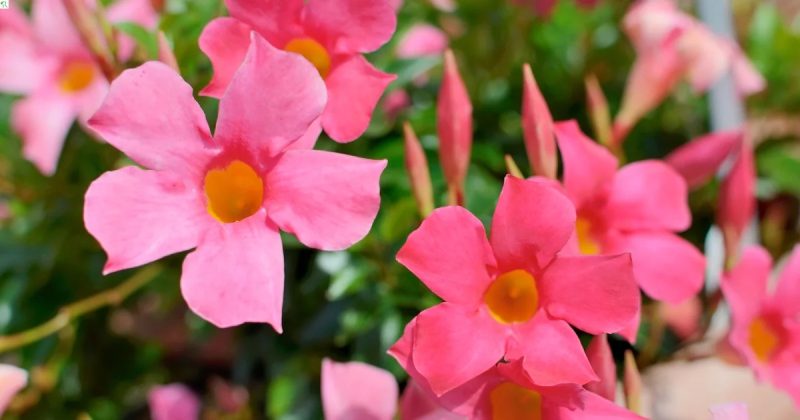Mandevilla plants are popular for their vibrant trumpet-shaped flowers and lush green foliage. These tropical climbers bring a touch of elegance to any garden, patio, or indoor setting.
In this comprehensive guide, we will cover everything you need to know about growing and caring for Mandevilla plants.
Overview of Mandevilla Plant Care

- Botanical Name: Mandevilla spp.
- Common Names: Rock trumpet, Dipladenia
- Plant Type: Perennial vine
- USDA Hardiness Zones: 9-11 (grown as an annual in colder zones)
- Sunlight: Full sun to partial shade
- Soil: Well-draining, slightly acidic (pH 5.5-6.5)
- Watering: Regular, allowing the top inch of soil to dry out between waterings
- Fertilizing: Every 2-4 weeks during the growing season
- Pruning: Late winter or early spring before new growth starts
- Common Pests: Aphids, spider mites, mealybugs
- Common Diseases: Root rot, powdery mildew, leaf spot
- Propagation: Cuttings and seeds
- Indoor Growing: Possible with bright light and humidity
What is a Mandevilla Plant?
Mandevilla is a genus of flowering vines native to Central and South America. These plants belong to the Apocynaceae family, which includes other ornamental species like oleander and periwinkle. Known for their rapid growth and striking trumpet-shaped flowers, Mandevilla vines are popular in gardens, patios, and balconies due to their ability to climb trellises and fences, creating a lush, tropical aesthetic. Their vibrant blooms, available in shades of pink, red, white, and yellow, make them a favorite among gardeners seeking long-lasting color and beauty.
These heat-loving plants thrive in warm climates and are commonly grown as perennials in USDA hardiness zones 9-11. In cooler regions, Mandevilla can be grown as an annual or overwintered indoors to protect them from frost. They prefer full sun to partial shade and require well-draining soil to flourish. With proper care, including regular watering and fertilization, Mandevilla plants can produce continuous blooms from spring through fall, adding elegance and charm to any outdoor space.
Aside from their ornamental appeal, Mandevilla vines attract pollinators like hummingbirds and butterflies, further enhancing garden biodiversity. While they are relatively low-maintenance, their milky sap contains toxic compounds that can be harmful if ingested, making them unsuitable for households with pets or small children. Despite this, their stunning floral displays and vigorous growth make them a cherished addition to tropical and subtropical gardens.
Mandevilla Plant Growing Conditions
Light Requirements
Mandevilla plants need bright, indirect sunlight to flourish, requiring at least six to eight hours of exposure each day. When grown outdoors, they prefer a location that receives full morning sun, as it provides gentle warmth to stimulate growth while reducing the risk of leaf scorch. In particularly hot climates, some afternoon shade is beneficial to prevent stress caused by excessive heat.
When cultivated indoors, these plants should be placed near a south- or west-facing window where they can receive ample natural light. If natural sunlight is insufficient, artificial grow lights can help supplement their needs, ensuring strong vine development and continuous flowering. Without adequate light, Mandevilla may become leggy and produce fewer blooms, making proper placement essential for their health.
Soil Requirements
A well-draining, slightly acidic soil mix is best suited for Mandevilla, with an ideal pH range of 5.5 to 6.5. These plants do not tolerate heavy, compacted soils that retain excessive moisture, as poor drainage can lead to root rot and fungal diseases. A high-quality potting mix enriched with perlite or coarse sand improves aeration and prevents waterlogging, creating the ideal environment for healthy root growth.
For additional nourishment, mixing organic compost or well-aged manure into the soil can enhance fertility and provide essential nutrients. Gardeners growing Mandevilla in pots should ensure their containers have drainage holes to allow excess water to escape. Using a lightweight, peat-based potting mix formulated for flowering vines or tropical plants can further optimize soil conditions, supporting vigorous growth and prolific blooming.
Temperature and Humidity
Mandevilla plants thrive in warm temperatures ranging between 65-85°F (18-29°C), making them well-suited for tropical and subtropical environments. Since they are highly sensitive to cold, temperatures below 50°F (10°C) can cause stress, leading to leaf drop and slowed growth. In regions with colder winters, Mandevilla should be brought indoors or placed in a greenhouse to protect them from frost damage. If grown outdoors, they should only be planted in the ground in areas within USDA hardiness zones 9-11, where mild winters allow them to survive year-round.
Humidity is another crucial factor in maintaining healthy foliage and flower production. Mandevilla plants prefer moderate to high humidity levels, similar to their native rainforest habitats. If the surrounding air is too dry, the leaves may turn brown at the edges, and flower buds may drop prematurely. To maintain ideal humidity, occasional misting with distilled water can provide extra moisture without overwatering the soil. Alternatively, placing a tray filled with water and pebbles beneath the plant or using a room humidifier can create a consistently humid environment, ensuring optimal growth conditions.
How to Plant Mandevilla
Choosing the Right Location
Selecting an appropriate location is crucial for the healthy growth of a Mandevilla plant. These tropical vines thrive in full sun to partial shade, with at least six hours of direct sunlight each day. While they can tolerate some shade, insufficient light may result in fewer blooms and slower growth. The chosen site should also have well-draining soil to prevent water from accumulating around the roots, which can lead to rot.
For gardeners in cooler climates, planting Mandevilla in containers is an excellent option, as it allows for easy relocation indoors when temperatures drop. If planting directly in the ground, ensure the soil is loose, fertile, and enriched with organic matter to provide the best growing conditions.
Planting in the Ground
Before planting, prepare the soil by loosening it and mixing in compost or well-rotted manure to improve drainage and nutrient content. Dig a hole that is twice as wide and slightly deeper than the root ball to allow the roots ample space to spread. Carefully remove the plant from its nursery pot, gently loosen any compacted roots, and place it in the hole at the same depth it was previously growing.
Backfill with soil, pressing it lightly around the base to remove air pockets. Water thoroughly to help the roots establish and ensure good contact with the surrounding soil. Applying a layer of mulch around the base helps retain moisture, regulate soil temperature, and suppress weed growth, but it should be kept a few inches away from the stem to prevent rot.
Planting in Containers
When growing Mandevilla in containers, selecting the right pot is essential. Choose a container with drainage holes to prevent excess water from accumulating. A pot that is at least 12-14 inches in diameter provides enough space for root development, ensuring the plant remains healthy as it matures.
Fill the container with a well-draining potting mix that includes perlite, sand, or orchid bark to enhance aeration. Place the Mandevilla in the center of the pot, ensuring the root ball sits at the same level as the surrounding soil. Gently pack the soil around the roots and water thoroughly to help settle it.
For climbing varieties, installing a trellis or stake at the time of planting is recommended to support their natural vining habit. This will encourage upward growth and prevent the stems from trailing on the ground. Position the container in a sunny location and rotate it occasionally to promote even growth on all sides.
Watering and Fertilizing Mandevilla
Watering Requirements
Mandevilla plants require consistent moisture to support their vigorous growth and abundant flowering, but overwatering can lead to root rot. The key is to water deeply whenever the top inch of soil feels dry. This ensures the roots receive adequate hydration without allowing excess water to accumulate. In hot weather, especially during peak summer months, more frequent watering may be necessary, particularly for container-grown plants, as soil in pots tends to dry out faster.
During the cooler months of fall and winter, when Mandevilla enters a period of slower growth or dormancy, watering should be reduced. The plant requires less moisture during this time, and allowing the soil to dry out slightly between waterings helps prevent issues like fungal infections. Using lukewarm water can also prevent temperature shock, especially for plants grown indoors. Ensuring proper drainage, whether in garden soil or containers, is crucial to maintaining healthy roots and preventing disease.
Fertilizing Schedule
Regular feeding helps Mandevilla maintain its lush foliage and produce continuous blooms throughout the growing season. From spring through summer, applying a balanced liquid fertilizer with an equal ratio of nitrogen, phosphorus, and potassium (such as 10-10-10) every two to four weeks provides essential nutrients for steady growth. For those aiming to maximize flower production, using a fertilizer with a higher phosphorus content, such as a bloom booster formula, can encourage more prolific flowering.
Slow-release granular fertilizers can also be used for a more gradual nutrient supply. When applying fertilizer, it’s important to follow the recommended dosage to prevent overfeeding, which can lead to excessive foliage growth at the expense of blooms. In the fall and winter months, fertilizing should be reduced or stopped entirely, as the plant’s growth naturally slows down. This seasonal adjustment prevents unnecessary stress and prepares the plant for dormancy or indoor overwintering.
Pruning and Training Mandevilla
When and How to Prune
Pruning Mandevilla at the right time helps maintain its shape, encourage vigorous growth, and promote more abundant blooms. The best time to prune is in late winter or early spring, just before new growth begins. This allows the plant to focus its energy on developing fresh, healthy shoots for the upcoming growing season.
When pruning, start by removing any dead, damaged, or diseased stems to improve airflow and prevent the spread of disease. Overgrown vines should be trimmed back to maintain a manageable size and encourage fuller growth. Cutting back about one-third of the plant’s total height can help rejuvenate the plant while still allowing it to recover quickly. Using clean, sharp pruning shears ensures clean cuts and reduces the risk of infection. If needed, light pruning can also be done throughout the growing season to control the shape and remove any leggy or unwanted growth.
Training Mandevilla to Climb
Mandevilla vines naturally climb and require support to showcase their full potential. Providing a sturdy structure such as a trellis, arbor, or stake gives the plant the support it needs to grow vertically and display its beautiful flowers. When selecting a support system, choose one that is tall and strong enough to accommodate the plant’s rapid growth and twining habit.
As the vines grow, gently guide them toward the support and secure them with soft plant ties or garden twine. Avoid tying the stems too tightly to prevent damage and allow for natural movement. Regularly checking and adjusting the ties ensures the plant remains well-supported without restricting its growth. If growing in a container, placing a decorative obelisk or bamboo stake inside the pot can provide an attractive and functional support system. With proper training, Mandevilla vines will create a stunning vertical display, making them a focal point in any garden or patio setting.
Common Pests and Diseases
Pests
Mandevilla plants are susceptible to several common garden pests that can weaken their growth and reduce flowering. Regularly inspecting the foliage and stems for early signs of infestation can help prevent severe damage.
Aphids are small, soft-bodied insects that cluster on new growth and the undersides of leaves, feeding on plant sap. Their feeding causes leaves to yellow and curl, and they can also introduce sooty mold. Washing the plant with a strong stream of water or applying insecticidal soap can effectively control aphid populations.
Spider mites are tiny pests that are often difficult to see but leave behind visible damage. They cause stippling or yellow speckling on leaves and may create fine webbing along stems and leaf undersides. Dry conditions encourage their spread, so increasing humidity and treating with neem oil or insecticidal soap can help manage infestations.
Mealybugs appear as white, cottony masses on stems, leaf nodes, and undersides of leaves. They feed on plant sap, weakening the plant and potentially leading to stunted growth. Removing them manually with a cotton swab dipped in rubbing alcohol or applying neem oil can effectively control their spread.
Diseases
Fungal and bacterial diseases can affect Mandevilla, particularly when growing conditions promote excessive moisture or poor air circulation. Preventing disease through proper care and early intervention is key to maintaining a healthy plant.
Root rot is one of the most serious issues, typically caused by overwatering or poorly draining soil. Affected roots become mushy and black, leading to wilting and yellowing leaves. Ensuring the plant is grown in well-draining soil and allowing the top layer to dry out between waterings helps prevent this condition. If root rot is detected, removing the affected roots and repotting in fresh soil can sometimes save the plant.
Powdery mildew appears as white, powdery spots on the leaves and thrives in humid conditions with poor air circulation. It can weaken the plant and reduce flowering. To prevent its spread, ensure good airflow around the plant and treat affected areas with a fungicide or a homemade solution of baking soda and water.
Leaf spot manifests as brown or yellow spots on the foliage, often caused by fungal or bacterial infections. If left untreated, it can spread and lead to premature leaf drop. Removing infected leaves, improving air circulation, and applying a fungicide can help manage the problem and prevent further spread.
Propagating Mandevilla
Propagation by Cuttings
One of the most reliable and quickest ways to propagate Mandevilla is through stem cuttings. This method ensures that the new plants retain the same characteristics as the parent plant, including flower color and growth habit. The best time to take cuttings is in spring or early summer when the plant is actively growing.
To propagate by cuttings, select a healthy, non-flowering stem and take a 4-6 inch section using sharp, sterilized pruning shears. Remove the lower leaves to expose the nodes, which will encourage root formation. Dipping the cut end in rooting hormone helps accelerate the rooting process. The cutting should then be planted in a well-draining potting mix, such as a combination of peat and perlite, to provide optimal moisture retention and aeration.
To maintain high humidity, cover the pot with a plastic bag or place it in a propagation dome. This prevents excessive moisture loss while allowing the cutting to establish roots. Keep the container in a warm location with indirect light, ensuring the soil remains consistently moist but not soggy. Root development usually takes a few weeks, after which the new plant can be gradually acclimated to normal growing conditions.
Propagation by Seeds
Growing Mandevilla from seeds requires more patience compared to cuttings, but it can be a rewarding way to cultivate new plants. Seeds should be collected from mature seed pods that have dried and begun to split open. Since Mandevilla seeds have a lower germination rate, planting multiple seeds increases the likelihood of successful growth.
To begin propagation, sow the seeds in a light, well-draining seed-starting mix, pressing them gently into the soil without burying them too deeply. Keeping the soil consistently moist is crucial, but overwatering should be avoided to prevent fungal issues. A warm environment with temperatures between 70-80°F encourages germination, so placing the seed tray on a heat mat can help speed up the process.
Germination can take several weeks, and once the seedlings develop several true leaves, they can be carefully transplanted into individual pots. Providing bright, indirect light and maintaining proper moisture levels will help the young plants establish strong roots before being moved to a permanent location.
Overwintering Mandevilla
In regions where temperatures drop below 50°F, Mandevilla cannot survive outdoors and must be overwintered indoors. Proper overwintering ensures the plant remains healthy and can resume vigorous growth in the spring.
Before bringing the plant inside, it is essential to prune it back to a manageable size. Cutting back about one-third of the plant helps reduce stress and prevents excessive legginess during its dormant phase. Removing any dead or damaged stems also encourages healthier regrowth when the plant becomes active again.
Once indoors, place Mandevilla in a bright but cool location where temperatures remain between 50-60°F. A south-facing window, sunroom, or enclosed porch with sufficient light is ideal. The plant will enter a semi-dormant state during winter, so watering should be significantly reduced. Allow the soil to dry out slightly between waterings to prevent root rot, as the plant’s reduced growth means it requires less moisture.
Throughout the winter, avoid fertilizing, as the plant is not in an active growing phase. In early spring, as daylight hours increase and temperatures warm up, gradually reintroduce Mandevilla to regular care. Resuming normal watering and feeding will help encourage new growth, and the plant can be moved back outdoors once nighttime temperatures remain consistently above 50°F.
Growing Mandevilla Indoors
Mandevilla can thrive indoors with the right care, making it a beautiful houseplant that adds a tropical touch to indoor spaces. Since these plants naturally prefer warm, sunny environments, replicating their ideal growing conditions indoors is essential for healthy growth and flowering.
Providing sufficient light is the most important factor when growing Mandevilla inside. A bright south- or west-facing window is ideal, as the plant needs at least six hours of sunlight per day. If natural light is limited, supplementing with a full-spectrum grow light can help maintain healthy foliage and encourage blooming. Positioning the light close to the plant and keeping it on for 10-12 hours daily can mimic outdoor sunlight conditions.
Humidity is another key requirement for indoor Mandevilla. Since indoor air tends to be drier, particularly in winter, maintaining adequate humidity levels is necessary to prevent leaf drying and stress. Placing a humidity tray with pebbles and water beneath the plant, misting the leaves occasionally, or using a room humidifier can help maintain optimal moisture levels.
Proper air circulation is crucial to prevent fungal diseases, especially in a confined indoor environment. Keeping Mandevilla away from cold drafts, such as those from air conditioners or heating vents, helps prevent stress and leaf drop. Regularly checking for pests like spider mites and aphids is also important, as indoor conditions can sometimes encourage infestations.
Conclusion
Mandevilla plants are a fantastic addition to any garden or home. With the right care, they reward growers with beautiful, long-lasting blooms. By following the proper growing conditions, watering practices, and pest management strategies outlined in this guide, you can enjoy a thriving Mandevilla plant year-round.






